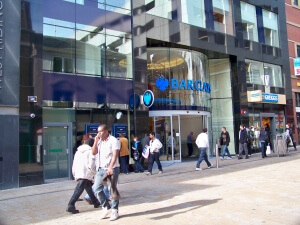The rise and rise of interbank FX giants: Barclays ditches entire Euro retail business while BARX platform dominates Tier 1 liquidity sector
Barclays has completed its absolute divestment from European branch banking, selling its remaining 74 branches in France to AnaCap Financial Partners. This means a complete concentration – and domination – in the interbank FX markets for Barclays BARX platform, as last look execution lives on and becomes even more of a core business activity

Barclays is the world’s third largest Tier 1 FX dealer by volume, with 8.11% of the world’s order flow going through its books.
Barclays is also one of Europe’s largest retail traditional banking institutions, with a network across the entire continent from its base in London.
…or rather it was one of Europe’s largest traditional banking institutions.
It is clear that economies of scale are vital for large financial institutions, however Barclays is conducting its dominance by focusing on FX and other interbank derivatives asset classes rather than its traditional business, as today the British company has completed its complete exit from the European market’s traditional banking sector, culminating in the sale of the final remaining 74 branches in France to private equity firm AnaCap Financial Partners, meaning that it now can concentrate its efforts solely on being at the very forefront of London’s global electronic trading epicenter.
Structural changes to the markets, management upheaval among many big banks, new non-bank entrants and lack of volumes and volatility have seemingly levelled the playing field among the industry’s biggest firms.
The biggest change in the rankings this year is the decline of the combined market share of the top five global banks. Their market share peaked in 2009 at 61.5% and was still above 60% as recently as 2014.
By 2015, the top five banks accounted for just 44.7% of total volume, however Barclays battles it out in the race for supremecy with Citi and Deutsche Bank, both of which also conduct their entire business from London.
So, that is the end of Barclays’ operation of branch banking across European high streets, a direction that concludes the Bank’s offloading of its entire Barclaycard credit card operations in Spain and Portugal to Bancopopular-e, a total divestment of its stake in Barclays Africa, a complete dispensement of its Egyptian operations and the sale of its wealth and investment management business in Singapore and Hong Kong.
Meanwhile, on home territory, Barclays continues to stand out in terms of procedure and its domination of market practice with regard to electronic trading with its BARX single-dealer platform.
Barclays is one of the world’s most prominent proponents of the last look execution procedure, its BARX platform which provides FX liquidity by streaming indicative prices on an in house and third party platform basis.
Barclays’ corporate standpoint on the reasons why it uses last look methodology is that being one of the world’s largest interbank FX dealers, it does not generally seek to reject trade requests. However, electronic spot FX market-making is a highly competitive industry and for the reasons set out above it necessarily exposes the liquidity provider to the risk of trading on incorrect pricing.
Barclays maintains that last look functionality is used to protect against these risks and allows liquidity providers to show considerably tighter electronically streamed prices than they otherwise could – something that the bank considers beneficial to every user of electronic FX trading platforms.
Beneficial to who? That is the question.
In January this year, the Foreign Exchange Professionals Association (FXPA), held a webinar on examining the implications of last look for the FX markets.
Attorneys with Steptoe & Johnson on the ‘last look’ webinar, advised market makers to be more transparent about how their last look systems operate.
“Regulators take a very dim view of institutional practices that emphasize a lack of transparency and that encourage employees to give either misdirection or less than complete information to counterparties when direct questions are asked,” said Mike Miller, litigation partner at Steptoe & Johnson, who spoke during the webinar.
In one high-profile case, a global bank used its spot FX trading platform to reject unprofitable trades. When customers asked why the trades were rejected, the bank reportedly gave “vague or misleading answers,” said Steptoe partner Jason Weinstein who analyzed the case during the webinar.
After a regulatory settlement, the bank posted detailed disclosures on its web site and also paid a steep fine, setting a precedent that could impact other banks, brokers and market-making firms.
FinanceFeeds has spoken at length with a number of senior executives within the institutional and prime brokerage sector recently, many of which have openly stated that banks do not like firms that offer ‘no last look’ execution, despite the regulatory and government derision aimed at the practice.
Despite a $50 million settlement agreement with regulatory authorities this summer which was part of an agreement to settle a class action suit instigated by Axiom Investment Advisors over last look execution practices, the firm continues to operate in that basis, much to the annoyance of prime of primes and ECNs globally.
The practice of executing trades via ‘last look’ methodology has been the subject of regulatory discourse over recent times, however Barclays’ institutional BARX platform continues to offer a last look execution facility.
In May last year, Thomson Reuters and BATS Global Markets, some of hte largest institional FX platforms in the world, concurrently limited the last look facility on their platforms in order to move toward greater transparency in the FX market.
At that time, regulatory authorities in prominent institutional FX centers on both sides of the Atlantic, namely New York, Chicago and London, had begun to express concern about the efforts of interbank and institutional traders which sought to manipulate a range of financial markets.
Last summer, at the time during which BATS Global Markets and Thomson Reuters which owns the FXall ECN platform having bought it for $625 million in 2012, continued to offer last look, along with Barclays in the interbank sector, whilst most FX platforms had already prohibited last look execution.
In this particular cooperation with the authorities, Barclays is likely to provide vital information which will be required by investors in order to pursue other institutional market makers who could be construed to have benefited from trades having been rejected if the price had moved in favor of the customer.
For several years, this practice has been considered controversial, and central banks across the world are relatively averse to its existence, yet it continues to be part of the overall topography of institutional electronic trading at Tier 1 bank level, thus by its very standing at the very top of the trade pricing and execution structure, is a practice which filters down by default and affects all components via aggregated liquidity feeds and eventually to retail brokerages.
In May 2015, BATS Global Markets, which operates institutional multi-asset platforms and now owns major institutional ECN Hotspot FX having bought it from KCG for $365 million, began to curb the practice over a course of several weeks, placing limits on how many ‘last look’ orders could be executed in order to take its own step in increasing transparency in the non-bank FX market.
Admirable indeed, perhaps. However, although certain measures such as this have been taken by large institutional firms, EBS, the electronic brokerage division of British interdealer broker ICAP, having gone a stage further in February this year by implementing a policy which aimed to abolish the need for last look execution altogether with the launch of the firm’s new EBS Live Ultra price feed which streams real-time market data from EBS Live which is operated by the firms EBS Broker Tec division, last look is alive and well at bank level.
Whilst not a mandatory implementation, EBS stated at the time that it took this action as a result of feedback and demand from corporate clients.
This is indeed all very well, however major banks are creating a double edged sword with regard to execution and provision of Tier 1 liquidity.
On one hand, banks have become extremely cautious with regard to extending credit to prime brokerages in order to provide aggregated liquidity feeds to the OTC derivatives market, Citigroup, the largest FX dealer by volume in the world with over 16% of all global FX order flow being handled from its Canary Wharf office, stated this year that it predicts a 56% potential default rate from OTC derivatives participants on counterparty credit, yet on the other hand, the very same banks are picking and choosing which trades to exit if the market moves against them, to the detriment of brokerages and liquidity providers globally.
That Barclays has reduced the size of its retail operations substantially across all retail sectors, and is still dominating London’s skyline and the world’s FX liquidity industry whilst still being able to execute on a last look basis is testimony to Barclays’ tenacity in wishing to concentrate its efforts on electronic trading.
Additionally, Barclays will not give FX brokerages or any OTC derivatives company a bank account these days. In some cases, they will even close accounts of firms with whom they have had a long standing corporate relationship with, causing them to have to seek alternative arrangements in the third tier banking system, which is frought with its own dangers.
Derivative asset exposures at Barclays in 2015 were £295 billion, which was lower than reported if netting was permitted for assets and liabilities with the same counterparty, or for which Barclays holds cash collateral.
Similarly, derivative liabilities for 2015 stood at £295 billion. In addition, non-cash collateral of £7 billion was held in respect of derivative assets. Barclays also received collateral from clients in support of over the counter derivative transactions.
It is only a matter of time before the interbank dealers of the world are specialists in that particular area, and retail banking is conducted online by totally separate companies dedicated to that specific purpose of serving retail customers only.









